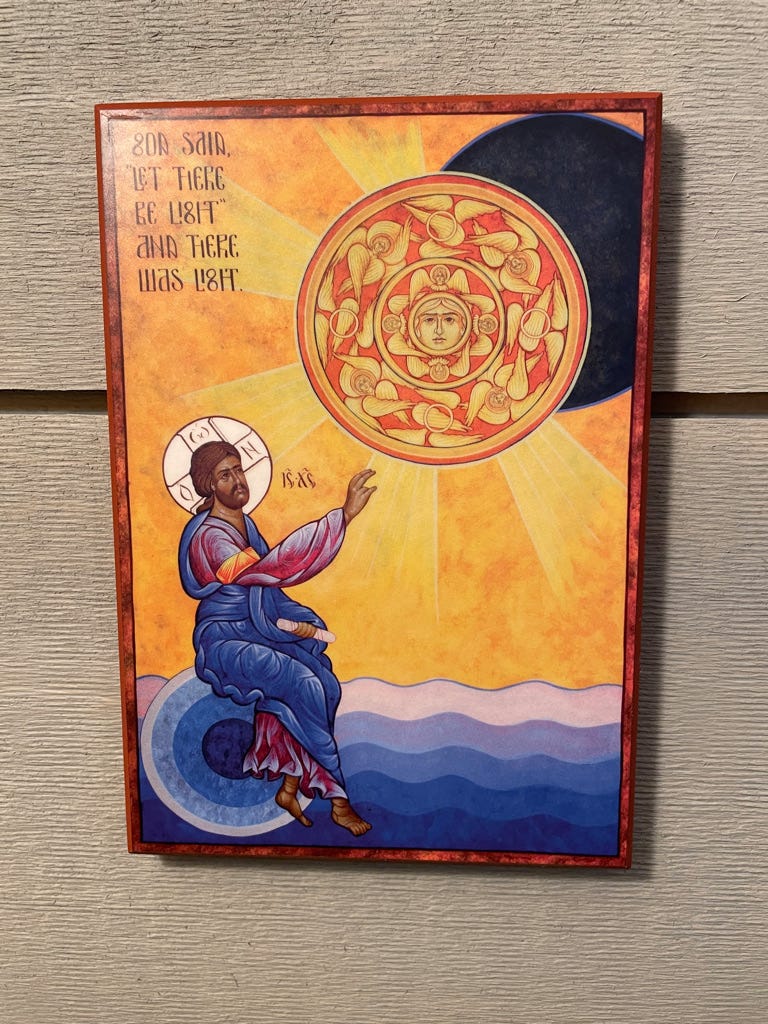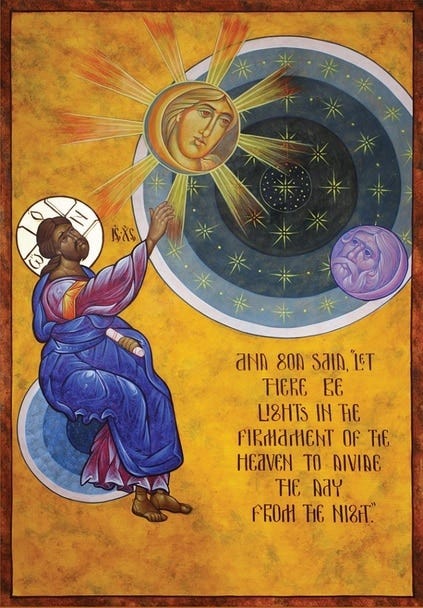The Creation of Light
How can one write about the origin of the solar system, the development of animal vision, temples, and icons, all in one post?
I bought this wonderful icon from the Ancient Faith store recently:
It’s a picture of Jesus on the first day of creation, commanding the light to exist. The full account of the day reads thus:
Then God said, “Let there be light,” and there was light. God saw that the light was good, and God separated the light from the darkness. God called the light “day,” and the darkness he called “night.” There was an evening, and there was a morning: one day. Genesis 1:3-5, CSB
The picture clearly shows the separation of the light from the darkness. It’s a wonderful depiction of the first day of creation. However, as a scientist and someone who has been reading about the “creation/evolution controversy” for all of my life, I noted something very interesting about the depiction of the light.
I don’t know what the artist was thinking about the source of the light when they drew this picture, but it’s very clearly the Sun. It’s circular, it has rays coming off of it, and it’s (mostly) yellow. It’s true that it’s got angels in it or on it, which is not normally what we think about the Sun, but the concept of angels at the creation is biblical in any case.
So what, you may say? It totally makes sense—the Sun is what separates the day from the night in everyday experience. However, as you may remember, in the Genesis 1 creation account, the Sun is created on Day 4, as depicted in this icon from the same set (which is currently out of stock!):
Note the obvious similarities between the Sun in this icon and the source of light in the first icon (sans the angels). It seems rather obvious that they’re the same object.
This has been a puzzlement to readers and commentators on the Genesis 1 creation account for centuries: what separates the day from the night on Day 1 if it’s not the Sun, which isn’t around until Day 4? What gives the first plants on Day 3 their light? These aren’t just questions that nosy scientific moderns ask. St. Augustine famously wondered what was going on here as well.
Scientifically speaking, the solar system was formed roughly 4.6 billion years ago, and the Sun and the Earth formed from the same collapsing cloud of gas and dust. Recognizing this, astrophysicist and old-earth creationist Hugh Ross, who adopts an interpretation of the Genesis account where the days of creation are long, billion-years-old periods of time, has long posited that the creation of light on Day 1 is from the Sun, and that the thick atmospheric makeup of the early Earth simply prevents anyone standing on the surface (the point of view from which the account is written) from recognizing it until billions of years later, after advanced life-forms have transformed the atmosphere from translucent to transparent, and the Sun, Moon, and stars can be seen on the geological equivalent of Day 4 (see this video where he explains this interpretation). An even more speculative and provocative proposal along similar lines is advanced by evolutionary biologist Andrew Parker, who in his book The Genesis Enigma points out that the first creatures to have evolved the eyes to actually see the Sun (as opposed to just having light-sensitive spots) did not occur until billions of years after its creation, again on Day 4 in the day-age scheme. Other interpretations striving to be faithful to the Genesis 1 text while accepting the scientific account of the origin of the solar system as well as its age, argue that the days are not meant to be chronological or consecutive at all. Others have seen the creation of light on Day 1 as the light emerging from the big bang.
Modern-day young-earth creationists, denying the antiquity of the Earth and universe despite the scientific evidence, posit a source of light (and gravity, it appears), sitting at the position of what would be the Sun, shining on the Earth with the same brightness as the Sun, as the Earth revolves around it in the exact same orbit as today and rotating around its axis in the same way as today. They insist that this is what is needed to read the Genesis 1 account literally and as a fully accurate account of the creation of the universe, which begins with nothing but an Earth which is formless, empty, and watery. Interpretations like those from Ross, Parker, and others, in their view, are not taking the Bible literally as one should, and are letting science dictate our view of Scripture.
So there’s light on Day 1, but no Sun—but we need a light which is basically exactly like the Sun in every relevant way, except that it’s not the Sun.
Wait, what?
Ironically, this complicated young-earth proposal for the source of light on Day 1, far from being a “plain, literal reading” of the text without letting science influence our interpretation, is in fact an interpretation which is only possible with scientific knowledge that the Bible writers would not have had. They did not know that the Earth rotated around the Sun, or that the Sun was much larger than the Earth, or that it is a source of gravity which keeps Earth in its orbit. Any suggestion that they did know this because it was revealed to them by God is pure speculation and is not supported by any biblical evidence. The same can be said for the day-age interpretations described above, even though they get the science right on the age of the solar system.
Maybe the day-age folks are right and God revealed the creation account in Genesis in such a way that thousands of years later some of us would see hints of modern scientific discoveries in it, and believe in its veracity as a result. I used to be a big fan of this approach, and I cannot rule it out. But I have come to understand (with the help of many authors such as John Walton and his book The Lost World of Genesis One) that it’s most important for us to begin interpreting Genesis 1 in the way that the people who wrote it and the people they originally wrote it for would have—it’s first and foremost a story about God and how he created this vast cosmos to serve as a temple-dwelling for himself to reside in and be in relationship with his creatures, especially his image-bearing humans.
That brings me back to the icon. It’s telling the story of the creation of light and the separation of light from the darkness. But the focus of the icon is God himself in the person of Jesus. It’s not an accident that St. John writes “The Word became flesh and dwelt among us” (John 1:14, CSB). The Greek word for “dwelt” here is actually “tabernacled”, evoking the Tabernacle of the Exodus, the portable temple that the people of Israel carried around with them. God seeks to be intimately present with us in his creation, whether it’s in the tabernacle, the temple, bread and wine, or most fully in the person of Jesus. It’s certainly fun to speculate about the days of Genesis and how they stack up against the history of the universe as revealed by science, but for the Christian the Genesis 1 account must first and foremost serve as the glorious statement of God’s gift of existence and his desire to be in relationship with it.


